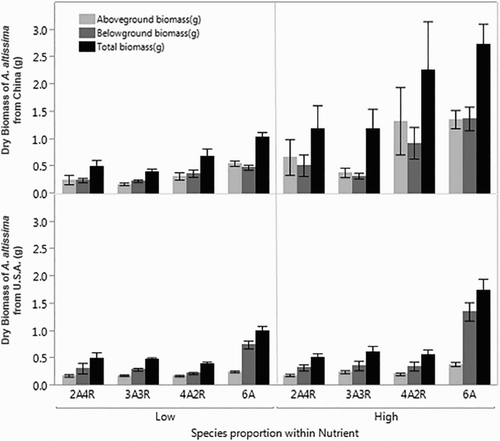Figures & data
Table 1. Mean ± 1 standard error of total biomass, leaf biomass and root/shoot ratio per plant of Ailanthus altissima and Robinia pseudoacacia seedlings with different seed source, nutrient and proportion treatments.
Table 2. Results from three-way ANOVAs of seedling growth metrics for Ailanthus altissima growing in a full-factorial substitutive design competition experiment with Robinia pseudoacacia in a greenhouse environment.
Table 3. Results from three-way ANOVAs of seedling growth metrics for Robinia pseudoacacia growing in a full-factorial substitutive design competition experiment with Ailanthus altissima in a greenhouse environment.
Figure 1. Aboveground, belowground and total biomass of Ailanthus altissima in a full-factorial substitutive design experiment with Robinia pseudoacacia at constant density (six plants per 8 L pot). The solid bars and error bars represent the average biomass per A. altissima plant and the standard error within each treatment group. The upper graph represents the results from an experiment using A. altissima seedlings from a Chinese seed lot, and the lower graph represents A. altissima seedlings grown from a West Virginia, US seed lot. Two nutrient levels (low and high) were used for the experiment, along with the four different proportions of A. altissima and R. pseudoacacia. (e.g. 2A4R = two A. altissima and four R. pseudoacacia seedlings; 3A3R = three A. altissima and three R. pseudoacacia seedlings).

Figure 2. Aboveground, belowground and total biomass of Robinia pseudoacacia seedlings in a full-factorial substitutive design experiment with Ailanthus altissima at a constant density (six plants per 8 L pot). The solid bars and error bars represent the average biomass per R. pseudoacacia plant and the standard error within each treatment group. The upper graph represents the results from an experiment using A. altissima seedlings from a Chinese seed lot, and the lower graph represents using A. altissima seedlings grown from a West Virginia, US seed lot. Two nutrient levels were used for the experiment, along with four different proportions of R. pseudoacacia and A. altissima seedlings. (e.g. 2R4A = two R. pseudoacacia and four A. altissima seedlings; 3R3A = three R. pseudoacacia and three A. altissima seedlings).

